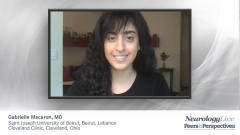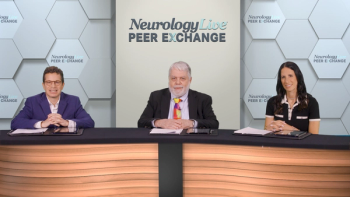
S1P Receptor Modulators for RRMS
What to know about using S1P receptor modulators as oral therapy for relapsing-remitting multiple sclerosis.
Episodes in this series

Jennifer Graves, MD, PhD, MAS: Let’s move on to S1P [sphingosine 1-phosphate] receptor modulators. We’ve seen a great expansion in options in that class over the last couple of years. Dr Macaron, could you start us off with your reflections on the clinical trial data and comparisons of these medications?
Gabrielle Macaron, MD: There’s a lot to say about this class, but I’m going to start with the general mechanism of action and how those drugs work. S1P receptor moderators have a distinct mechanism of action because they’re going to retain lymphocytes in the lymph nodes and secondary lymphoid tissues. They do that by binding to the S1P receptor on the lymphocyte and preventing S1P-dependent egress of the lymph node, specifically naive and memory T cells which are going to stay in the lymph node, not go in the blood, and subsequently not penetrate the central nervous system.
There are 5 S1P receptors. S1P1 is the main one that’s linked to the desired immunological effect of this class of medications. All 5 of the receptors are linked to a certain extent to the occurrence of the nonimmunological adverse effects that we don’t want with this medication. That’s the logic in the development of the more selective S1P receptor modulators in the recent years. Of course, fingolimod’s [Gilenya] efficacy was established a long time ago. The 2 pivotal trials, FREEDOMS and TRANSFORMS, have shown its efficacy. Later on, there were the open-label extension studies and several real-world cohorts and efficacy studies in a real-world cohort that confirmed these findings. Overall, fingolimod is considered a moderate-to-high efficacy oral medication. It was tested against placebo in the trials, and it decreases the annualized relapse rate around 55% and the development of MRI activity almost 90%. It’s a very efficient medication.
As you mentioned earlier, pretreatment workup might seem like too much, but it’s mandatory to mitigate the risk of severe infections, especially VZV [varicella-zoster virus] infections that can be very severe on this medication; macular edema, which happens very rarely and usually in patients who have preexisting macular problems such as diabetes; and bradyarrhythmia. We all know that the first dose should be given under surveillance because of the risk of atrioventricular slowing, which happens very rarely. I’ve seen it once. Because we do this big workup, the medication ends up not being that risky because you already assessed for those important adverse effects. It’s given at a dose of 0.5 mg once daily, which is quite an advantage of fingolimod.
There was a recent study that’s important to talk about: the ASSESS study. It assessed a lower dose of fingolimod, because when the medication was developed there weren’t other doses that were investigated during the development program. In this randomized controlled trial, around a thousand patients were enrolled and the efficacy of a lower dose of fingolimod was tested against the standard dose and against glatiramer acetate [Copaxone]. The concept was to see if we can maintain the same efficacy but decrease the adverse effect profile. The results showed that the 0.5-mg dose—the standard dose—is more efficient, and the adverse effect profile is quite similar between the 2 doses. This further reinforces the fact that 0.5 mg is the appropriate dose for fingolimod. This is relevant because some physicians try to decrease the dose when people have severe lymphopenia. That’s OK as long as we do it as a short-term thing, especially based on the results of this study.
Jennifer Graves, MD, PhD, MAS: Dr Shah and Dr Macaron, what do you think was unique or key about the study design for the ozanimod [Zeposia] SUNBEAM and RADIANCE trials?
Suma Shah, MD: What I recall about those trials were they were each done with a different duration of time, which was unique, while many of our studies often look at a 1-year follow-up. It was the RADIANCE trial that looked at a 24-month follow-up whereas SUNBEAM was a 12-month follow-up in patients on ozanimod compared with interferon beta-1a. The length of time helped us get a sense of our expected annualized relapse rate reduction. Between the 2 of them, it was between 38% to 45% or so compared with the interferons when patients were treated with ozanimod.
Gabrielle Macaron, MD: We can also mention the fact that they were both 3-arm trials and the 2 doses of ozanimod were tested. It was ozanimod hydrochloride 1 mg vs ozanimod hydrochloride 0.5 mg vs once a week interferon beta-1a. I specifically say hydrochloride because the dose of the ozanimod that we use is 0.92 mg. That’s the reason for the difference. It’s a slightly different molecule. Two doses were evaluated at the same time during those trials.
In the phase 3 SUNBEAM and RADIANCE trials, comparing 1 and 0.5 mg ozanimod and interferon beta-1a was tricky. Ozanimod was more effective in decreasing the annualized relapse rate, new T2 lesions, and gadolinium-enhancing lesions, which were the primary outcome. Interestingly, ozanimod was also more effective in reducing brain volume loss, including whole brain volume, and also cortical gray matter and thalamic volume loss. This is a great advantage and very good data to know.
Jennifer Graves, MD, PhD, MAS: Thank you for watching this Neurology Live® Peer Exchange. If you enjoyed the content, please subscribe to our e-newsletters to receive upcoming Peer Exchanges and other great content right in your inbox.
Transcript edited for clarity.
Newsletter
Keep your finger on the pulse of neurology—subscribe to NeurologyLive for expert interviews, new data, and breakthrough treatment updates.



